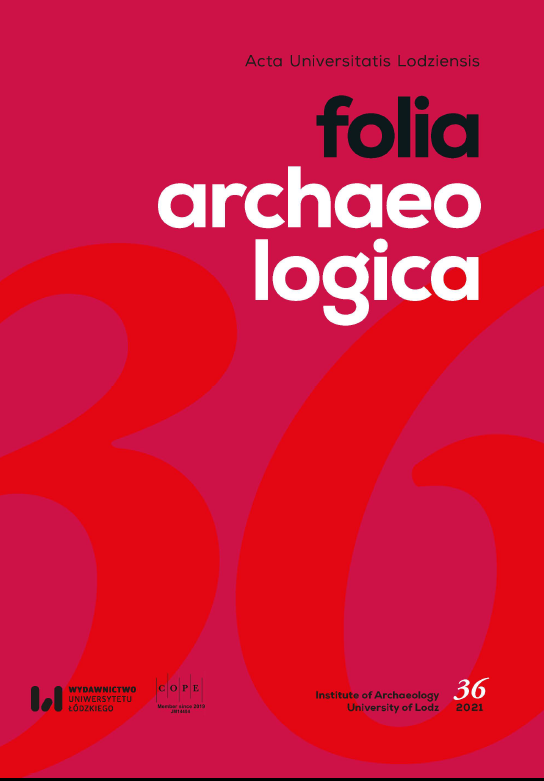Przygotowanie i spożywanie posiłków w świetle zabytków metalowych pozyskanych na stanowisku przy ulicy Wałowej 40 w Gdańsku
Preparation and Consumption of Meals in the Light of Metal Artefacts Discovered at Site Wałowa 40 in Gdańsk
Author(s): Marta WołyńskaSubject(s): History, Archaeology, Middle Ages
Published by: Wydawnictwo Uniwersytetu Łódzkiego
Keywords: Kitchen artefacts; tableware; knives; spoons; tankard; brass and tin crafts; manufacturer’s mark
Summary/Abstract: Due to a development plan concerning the plot at 40 Wałowa Street, archaeological works were carried out in its area in the years 2016–2017. The history of the research area was strongly influenced by its location in the contact point of three zones: Osiek, the Old Town and the Young Town. In the Middle Ages, a moat being part of fortifications was located in this place, while modern period fortifications of the northern front were built there in the 17th century. An extension of the zone within the ring of fortifications was related to filling up of the medieval moat. Garbage from the area of Gdańsk was in all probably used for this purpose. The fortifications ceased to fulfil their role and were dismantled in the 1890s. In the case of the examined area plots were then used for barracks buildings. These were destroyed in 1945 and no development activity took place there until the time of research.The paper offers a discussion of 31 finds acquired from the site at 40 Wałowa Street in Gdańsk. These artefacts were used for preparation and consumption of meals. In this work it was also attempted at completing the bibliography of modern period kitchen artefacts and those related to table culture. The artefacts discussed in the paper include 15 spoons, 13 knives, including one which forms a set with a fork, another two-pronged fork, as well as a tin tankard. Knives are a category of finds which is dealt with as a separate group in scholarly literature. Attempts at a functional classification have been undertaken within this group. As regards the finds from 40 Wałowa Street, the first criterion of classification was the original application of the artefacts. On the basis of this criterion the discussed assemblage was limited to 12 table knives and one kitchen knife. What was analysed was the form and ornament of the artefacts as well as the issue of manufacturer’s marks. A special attention was paid to the set of cutlery composed of the knife and the two-pronged fork, as well as to another fork of this type. These artefacts may have been used for serving meals from platters. The second group of artefacts were spoons. These included 12 pieces of cutlery and one kitchen spoon. Also in this case the morphology, ornamentation, as well as marks on the artefacts were dealt with. Some of the finds can be related to local workshops or even to a Gdańsk manufacturer who is known by name, that is, a non-guild craftsman Peter Draland. The tin tankard is an exceptional find which increases the exhibition value of the assemblage. The author of this paper knows merely three tin pieces of tableware, such as Hanseatic jugs and a salt-cellar which were discovered in the course of excavations in Gdańsk. Artefacts made from this metal, due to related financial and social aspects such as a considerable interest from purchasers, quality issues and problems of guild fights against non-guild craftsmen, were also a point of departure for a broader reflection on Gdańsk bronze and tin crafts.The discussed artefacts were acquired from a context dated to the period from the second half of the 16th to the 18th century. The lion’s share of finds (23) were revealed within an 18th c. well. However, most of these artefacts (19) were dated to the 17th century (19). Concerning the remaining ones (10), their chronology encompassed the 16th and 17th centuries. Sporadically, the finds were dated to the 15th–16th (1) or to the 18th century (1).Research on metal kitchen and table utensils in Gdańsk in the Modern Period calls for further analyses which should be based on a more numerous assemblage of finds. What is recommended is to process a higher number of artefacts which were acquired in the course of excavations and which are now solely known from museum inventories. It must be stressed that a high significance of the issues of kitchen and table culture consists both in their strong research potential and in considerable opportunities of using these problems for archaeological education and popularisation activities.
Journal: Acta Universitatis Lodziensis. Folia Archaeologica
- Issue Year: 2021
- Issue No: 36
- Page Range: 279-326
- Page Count: 48
- Language: Polish

